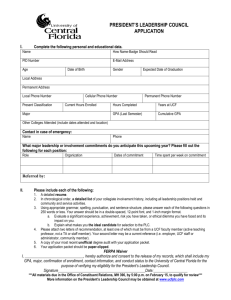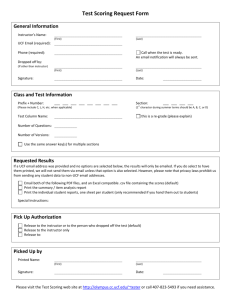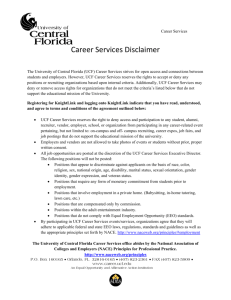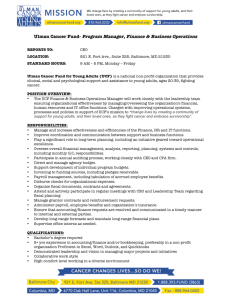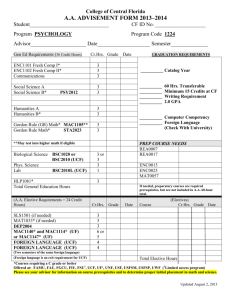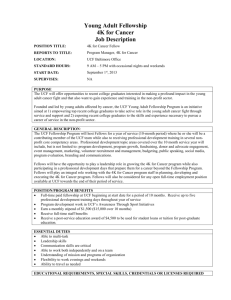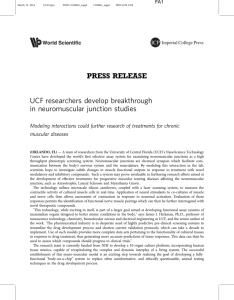the university of central florida case study
advertisement
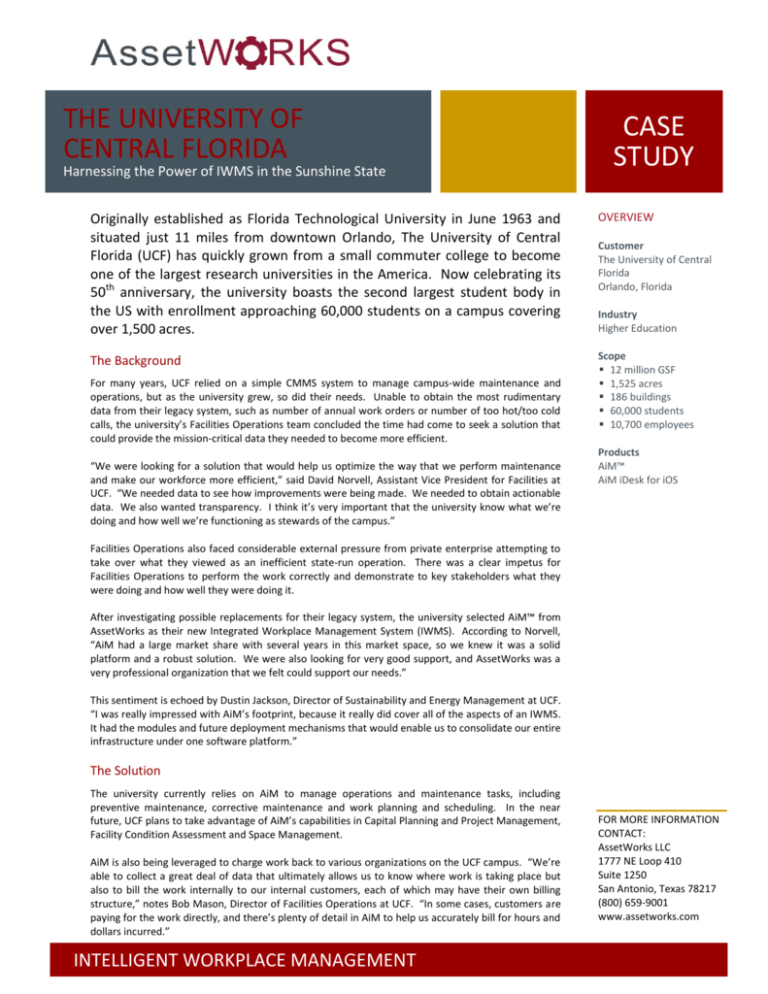
THE UNIVERSITY OF CENTRAL FLORIDA Harnessing the Power of IWMS in the Sunshine State CASE STUDY Originally established as Florida Technological University in June 1963 and situated just 11 miles from downtown Orlando, The University of Central Florida (UCF) has quickly grown from a small commuter college to become one of the largest research universities in the America. Now celebrating its 50th anniversary, the university boasts the second largest student body in the US with enrollment approaching 60,000 students on a campus covering over 1,500 acres. OVERVIEW The Background Scope 12 million GSF 1,525 acres 186 buildings 60,000 students 10,700 employees For many years, UCF relied on a simple CMMS system to manage campus-wide maintenance and operations, but as the university grew, so did their needs. Unable to obtain the most rudimentary data from their legacy system, such as number of annual work orders or number of too hot/too cold calls, the university’s Facilities Operations team concluded the time had come to seek a solution that could provide the mission-critical data they needed to become more efficient. “We were looking for a solution that would help us optimize the way that we perform maintenance and make our workforce more efficient,” said David Norvell, Assistant Vice President for Facilities at UCF. “We needed data to see how improvements were being made. We needed to obtain actionable data. We also wanted transparency. I think it’s very important that the university know what we’re doing and how well we’re functioning as stewards of the campus.” Customer The University of Central Florida Orlando, Florida Industry Higher Education Products AiM™ AiM iDesk for iOS Facilities Operations also faced considerable external pressure from private enterprise attempting to take over what they viewed as an inefficient state-run operation. There was a clear impetus for Facilities Operations to perform the work correctly and demonstrate to key stakeholders what they were doing and how well they were doing it. After investigating possible replacements for their legacy system, the university selected AiM™ from AssetWorks as their new Integrated Workplace Management System (IWMS). According to Norvell, “AiM had a large market share with several years in this market space, so we knew it was a solid platform and a robust solution. We were also looking for very good support, and AssetWorks was a very professional organization that we felt could support our needs.” This sentiment is echoed by Dustin Jackson, Director of Sustainability and Energy Management at UCF. “I was really impressed with AiM’s footprint, because it really did cover all of the aspects of an IWMS. It had the modules and future deployment mechanisms that would enable us to consolidate our entire infrastructure under one software platform.” The Solution The university currently relies on AiM to manage operations and maintenance tasks, including preventive maintenance, corrective maintenance and work planning and scheduling. In the near future, UCF plans to take advantage of AiM’s capabilities in Capital Planning and Project Management, Facility Condition Assessment and Space Management. AiM is also being leveraged to charge work back to various organizations on the UCF campus. “We’re able to collect a great deal of data that ultimately allows us to know where work is taking place but also to bill the work internally to our internal customers, each of which may have their own billing structure,” notes Bob Mason, Director of Facilities Operations at UCF. “In some cases, customers are paying for the work directly, and there’s plenty of detail in AiM to help us accurately bill for hours and dollars incurred.” INTELLIGENT WORKPLACE MANAGEMENT FOR MORE INFORMATION CONTACT: AssetWorks LLC 1777 NE Loop 410 Suite 1250 San Antonio, Texas 78217 (800) 659-9001 www.assetworks.com Ease of use and completeness of solution were paramount to UCF. According to Jackson, “From our original procurement of the software to installation, initial training and deployment, I was really shocked at how easy it was to use. I thought that with the feature sets that we were getting into with this really integrated solution, it would be a really taxing endeavor just to figure out how to use it and how to search for things. I think that was probably my biggest surprise—the ease of use and the depth of functionality right out of the box.” It’s an opinion shared by Mason. “In my past career, I’ve used perhaps a dozen different CMMS systems, and they’ve all sort of done the job. When I encountered AiM, I discovered that its data structure was much larger and more comprehensive and the data that’s collected is more robust. It’s got a lot of data features that can be sorted and reported on based on what you’re looking for.” The Results Having access to a broad swath of mission-critical data was a major goal at UCF and one met by AiM right out of the box. “A surprising feature of AiM was how well thought-out the platform was,” notes Jackson. “Compared to our previous solution, AiM is very developed and robust. Anything that we thought about during the original deployment, there was already a mechanism in place that supported it. It was just a matter of setting up our data to mimic that structure.” “We track six different metrics that we use to rate our organization,” said Norvell. “AiM gives us the data we need to determine the progress of the planning and scheduling processes we’re following. We track these weekly and we’re seeing those numbers improve every week.” This data ultimately helps the university to manage workloads and know precisely where work is taking place, which is a byproduct of detailed work planning, scheduling and execution. Accountability was another objective of the AiM deployment—accountability at every level, from the field workforce right up through management. AiM data is used by the university to make important decisions that hold people directly accountable for their jobs. UCF also wanted to increase the mobility, flexibility and productivity of the field workforce. Organizationally and culturally, Facilities Operations made the shift from shop-based maintenance to zone-based maintenance. Technologically, the university adopted the iDesk mobile platform for AiM. “To me, one of the strongest points of the AiM deployment—the biggest impact for us—has been the purchase of the iDesk mobile application and moving our workforce to a paperless environment,” notes Norvell. “So from day one with AiM, we’ve been paperless using iOS devices. Every technician has their own device, and that’s how they receive their work and track their hours. We’re planning to use iDesk in the future to perform assessments, where we’ll grade the level of service we’re providing, especially for more routine tasks like housekeeping and landscaping.” Not only have field personnel become more productive, but morale has improved because the staff now carries assignment lists that they control and can access from anywhere. Sustainability is also top of mind at UCF. As a signatory to the American College and University Presidents’ Climate Commitment or ACUPCC, the university is committed to becoming more energy efficient and curbing its environmental impact. “The capabilities of the IWMS system across all the various aspects of facilities allow us a better opportunity to see where our chances for improvements are in reducing our environmental footprint,” said Jackson. As such, the detailed tracking of work, space inventory, utilities and project planning under the IWMS umbrella has enabled the university to better understand where improvements are taking place in terms of their environmental footprint. INTELLIGENT WORKPLACE MANAGEMENT More specifically, improved tracking of work orders, personnel assignments to each work order, and reporting on which assets are being serviced is yielding measurable results in terms of energy efficiency. Perhaps the biggest gains have come in the area of preventive maintenance. “Our preventive maintenance program has improved a lot,” said Darin Kennedy, Business Analyst and Process Compliance Manager for UCF. “We have metrics—one in particular is preventive maintenance compliance—and these have consistently improved since we implemented AiM and our new workflow processes.” UCF originally set a goal of 100 percent PM compliance and completion, and using AiM, they have reached this goal. The ancillary, long-term benefits of improved preventive maintenance processes include greater equipment availability and reliability, improved life safety issues, significant reductions in corrective actions, and considerable cost savings. “Having this really robust solution for managing our preventive maintenance, we’ve been able to garner additional insight into what types of work we should be doing based on cost analysis and workload analysis of these preventive actions and determine which of these are translating into fewer corrective actions,” notes Jackson. “Our utility plants alone probably account for somewhere near 40-50 percent of our utilities for the entire campus, so small savings there actually is a tremendous amount of money.” Conclusion Before implementing AiM, UCF was unable to identify where their labor hours were being directed, but with AiM in place, the university can now track labor hours to the building, room and equipment level. “Through the process of analyzing this data, we’ve discovered that 20 percent of our buildings are occupying 80 percent of our time,” said Norvell. “And all this information helps us make decisions when we build new buildings—how to use different equipment and how to organize buildings differently.” Closely monitoring and controlling costs is also paramount. According to Jackson, “From a quantitative perspective, we’re now able to fully track how much work we’re doing, which boils down to cost for individual work orders, cost per asset, cost per building or cost per utility plant. That’s something we didn’t have before. Having those numbers now allows us to hone in and focus on improvements in those areas.” Jackson also points to the technical advantages AiM brings to the table. “AiM’s table structure allows us to create any number of reports, so if you have that skill set in-house, you can leverage a tremendous amount of information that you otherwise wouldn’t get,” he notes. “Also, the BIRT open source reporting mechanism that is available with AiM gives us a lot of reports that I wouldn’t have thought were even available, but everything can be developed. Just having this solid infrastructure behind the platform along with the AssetWorks support team has allowed us to do a tremendous amount more with the product than we initially thought we’d be able to.” Bob Mason sums up the AiM deployment very succinctly. “The end-game in utilizing AiM is really to improve efficiency and productivity within our organization. This is a big campus with lots of work orders, lots of people and a lot of need. The role of facilities management on this campus is ultimately to control the work.” And that’s just what AiM is doing. INTELLIGENT WORKPLACE MANAGEMENT
